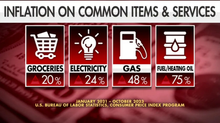The Fed’s Operating Losses Become Taxpayer Losses
The Daily Knight

Original article at The Federalist Society.
The year 2023 is shaping up to be a financially challenging one for the Federal Reserve System. The Fed is on track to post its first annual operating loss since 1915. The annual loss will be large, perhaps $80 billion or more, and this cash loss does not count the massive unrealized mark-to-market losses on the Fed’s fixed-rate securities portfolio. An operating loss of $80 billion would, if properly accounted for, leave the Fed with negative capital of $38 billion at year-end 2023. If interest rates stay at their current level or higher, the Fed’s operating losses will impact the federal budget for several years, requiring new tax revenues to offset the continuing loss of billions of dollars in Fed’s former remittances to the U.S. Treasury.
The Federal Reserve has already confirmed a substantial operating loss for the fourth quarter of 2022. Audited figures must wait for the Fed’s annual financial statements, but a preliminary Fed report for 2022 shows a fourth quarter operating loss of over $18 billion. The losses continued in January 2023, bringing the total loss since September to $27 billion, as shown in the Fed’s February 2 H.4.1 Report. Since it raised the cost of its deposits again by raising rates on February 1, the Fed is losing at an even faster rate. If short-term interest rates increase further going forward, the operating loss will correspondingly increase. Again, these are cash losses, and do not include the Fed’s unrealized, mark-to-market loss, which it reported as $1.1 trillion as of September 30, 2022.
The Fed obviously understood its risk of loss when it financed about $5 trillion in long-term, fixed rate, low-yielding mortgage and Treasury securities with floating rate liabilities. These quantitative easing (QE) purchases were a Fed gamble. In the past, with interest rates suppressed to historically minimal levels, the short-funded investments made the Fed a profit. But these investments, so funded, created a massive Fed interest rate risk exposure that could generate mind-boggling losses if interest rates rose—as they now have.
The return of high inflation required increases in short-term interest rates, but they are only back to normal historical levels. This pushed the cost of the Fed’s floating-rate liabilities much higher than the yield the Fed earns on its fixed-rate investments. Given the Fed’s 200-to-1 leverage ratio, higher short-term rates quickly turned the Fed’s previous profits into very large losses. The financial dynamics are exactly those of a giant 1980s Savings & Loan.
To cover its current operating losses, the Fed prints new dollars as needed. In the longer run, the Fed plans to recover its accumulated operating losses by retaining its seigniorage profits in the future, when its massive interest rate mismatch will finally have rolled off. This may take a while, since the Fed reports $4 trillion in assets with more than 10 years to maturity (see H.4.1 Report, Section 2). During this time, the future seigniorage earnings that otherwise would have been remitted to the U.S. Treasury, reducing the need for federal tax revenues, will not be remitted. It turns out the Fed’s gamble carried the risk that QE might generate taxpayer costs, costs that are being realized today. The Fed’s QE gamble has turned into a buy-now pay later policy—costing taxpayers billions in 2023, 2024, and additional years to pay for its QE purchases.
The Fed’s 2023 messaging problem is to justify spending tens of billions of taxpayer dollars without getting congressional pre-approval for the costly gamble. Did the Fed explain to Congress the risk of the gamble? The Fed now tries to downplay this embarrassing predicament by arguing that it can use non-standard accounting to call its growing losses by a different name: a “deferred asset.” They are assuredly not an asset of any kind, but properly considered are a reduction in capital. The political effects of the losses are complicated by the fact that most of the Fed’s exploding interest expense is paid to banks and other regulated financial institutions.
When Congress passed legislation in 2006 authorizing the Fed to pay interest on bank reserve balances, Congress was under the impression that the Fed would pay interest on required reserves, and a much lower rate of interest—if anything at all—on bank excess reserve balances. Besides, until 2008, excess reserve balances were very small, so the Fed’s interest expense on them was expected to be negligible.
Surprise! Since 2008, in response to events unanticipated by Congress and the Fed, the Fed vastly expanded its balance sheet, funding Treasury and mortgage securities purchases using bank reserves and reverse repurchase agreements. The Fed now pays interest on $3.1 trillion in bank reserves and interest on $2.5 trillion in repo borrowings, both of which are paid at interest rates that now far exceed the yields the Fed earns on its fixed-rate securities holdings. The Fed’s interest payments accrue to banks, primary dealers, mutual funds, and other financial institutions, while a significant share of the resulting losses will now be paid by current and future taxpayers.
It was long assumed that the Fed would always make profits with a positive fiscal impact. In 2023 and going forward, the Fed will negatively impact fiscal policy—something Congress never intended. Once Congress understands the current and potential future negative fiscal impact of the Fed’s monetary policy gamble, will it agree that the ongoing billions in Fed losses are no big deal?
Original article at The Federalist Society.
In Christ Crucified and the Most Victorious Heart of Jesus.
The Daily Knight, on behalf of the Knights Republic and the Ladies of the Most Victorious Heart of Jesus depend on its subscribers and supporters. Join the conversation and make a contribution today.
Click here to make a donation.
Click here to subscribe to The Daily Knight.











































Comments